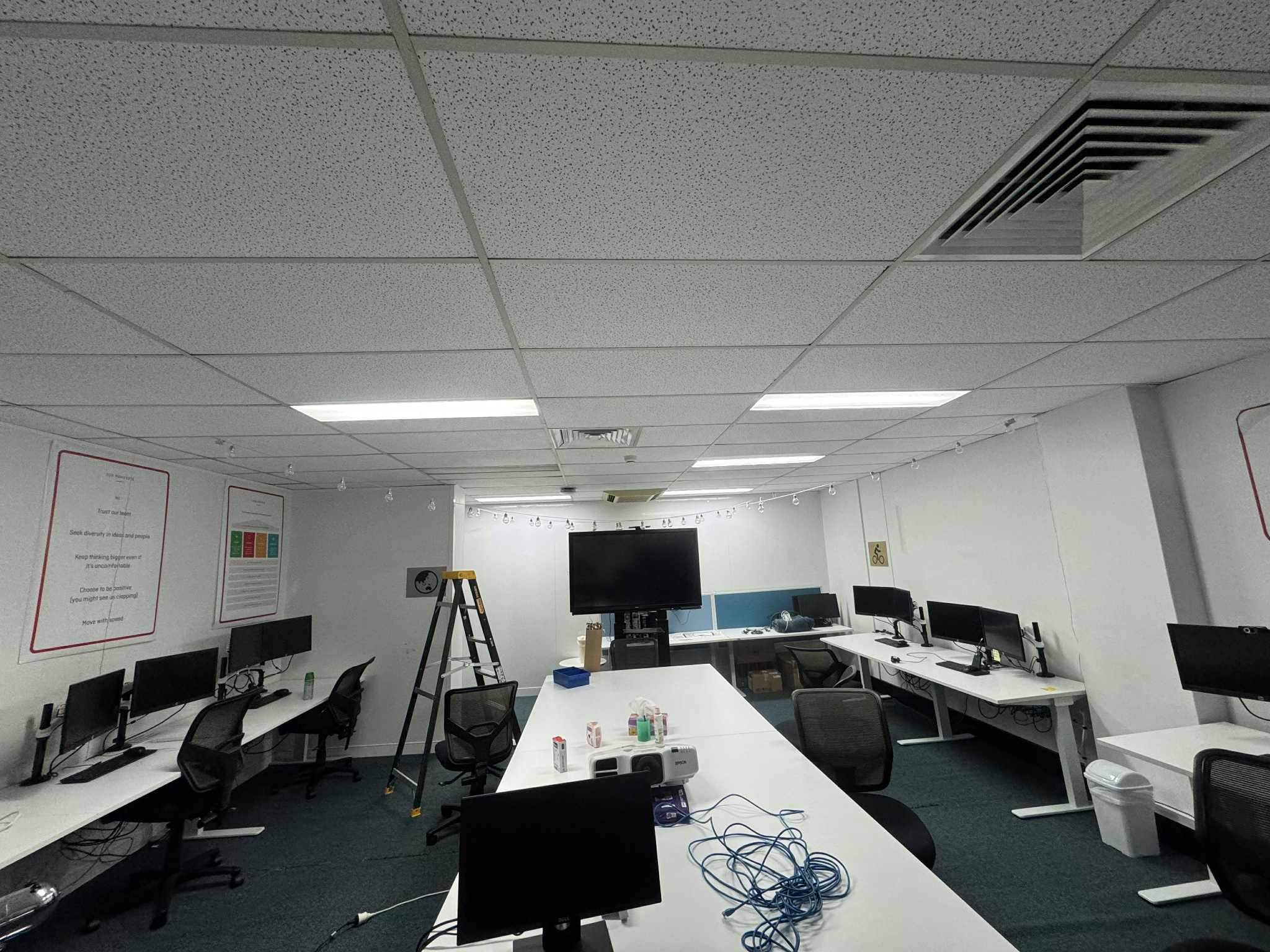Why Replace Legacy Fluorescents with LED?
- Lower energy use: Quality LED panels often use 40–60% less power than twin 36W fluorescent troffers (once ballast losses are included).
- Long service life: 50,000+ hour LED lifespans reduce call‑outs and disruption for lamp changes.
- Better light quality: Higher colour rendering (CRI), consistent colour temperature (often 4000K neutral white for offices) and reduced flicker mitigate eye strain.
- Reduced heat load: Less waste heat can marginally assist HVAC efficiency in conditioned spaces.
- Compliance & safety: A refit lets you address emergency lighting (AS/NZS 2293) & task lighting levels (AS/NZS 1680) at the same time.
Example Energy & Cost Savings (Illustrative)
Scenario: 50 x ageing recessed fluorescent troffers (2 × 36W tubes each). Including ballast losses, each fitting draws ≈80W. Proposed replacement: 50 x 30W LED edge‑lit panels with similar or better lumen output.
- Existing load: 50 × 80W = 4.0 kW
- LED load: 50 × 30W = 1.5 kW
- Operating profile: 10 hours/day, 5 days/week ≈ 260 working days/year
- Annual kWh (fluorescent): 4.0 kW × 10 × 260 = 10,400 kWh
- Annual kWh (LED): 1.5 kW × 10 × 260 = 3,900 kWh
- Estimated savings: 6,500 kWh/year
At an indicative blended electricity rate of $0.30/kWh: 6,500 × $0.30 ≈ $1,950/year saved on lighting energy alone (ex GST). Additional indirect savings (reduced re-lamping labour, less HVAC load) are not included.
Simple Payback (High-Level)
If supply & install of quality commercial LED panels averages $180 per fitting (varies with access, controls, emergency requirements), project cost ≈ $9,000. With ~$1,950/year energy savings:
- Estimated simple payback: ≈ 4.6 years
- Effective life horizon: 50,000 hours at 2,600 hours/year ≈ 19+ years (light depreciation & actual usage may shorten this)
- Real-world payback often improves when: adding occupancy/daylight sensors, leveraging tariff changes, or avoiding frequent tube & starter replacements.
Note: Actual pricing and payback depend on product specification, ceiling type, access equipment, control strategy, emergency fittings and any power factor or wiring corrections performed during the upgrade.
Lighting Design & Compliance Considerations
- Illuminance (lux): Open-plan offices commonly target 320–400 lux on the working plane (refer to AS/NZS 1680.1 & task‑specific parts).
- Uniformity: Even distribution reduces fatigue; quality panels and layout spacing matter.
- UGR / Glare: Low‑glare diffusers & correct mounting height minimise discomfort.
- Colour temperature: 4000K neutral white is a popular balance for alertness and comfort; reception or breakout zones may differ.
- Emergency & exit lighting: Ensure AS/NZS 2293 testing & logbook updates when fittings are altered.
Controls for Additional Savings
- Occupancy / vacancy sensors: Automatically switch or dim unused meeting rooms & store areas.
- Daylight harvesting: Sensor‑based dimming along window banks cuts daytime consumption.
- Time scheduling: Prevent after‑hours wastage—integrate with BMS where available.
- Task tuning: Set default light levels lower than maximum where full output isn’t required.
Practical Upgrade Tips
- Audit existing circuit loading & protective devices before adding drivers or rebalancing phases.
- Select branded drivers & panels with documented lumen maintenance (L70 / L80) and warranty support.
- Label circuits & update as‑built drawings for future maintenance.
- Coordinate ceiling access (e.g., after hours) to minimise disruption to staff.
Sample Rollout Sequence
- Site survey: count fittings, measure lux, note ceiling type & emergency locations.
- Design & product selection: panel size, lumen package, CCT, CRI, controls.
- Quote & ROI summary: energy model + installation scope.
- Staged installation after hours to limit downtime.
- Commission controls (sensors, dimming) & verify emergency lighting.
- Post‑upgrade verification: spot lux checks & client handover pack.
Environmental & ESG Benefits
Reduced kWh lowers Scope 2 emissions (subject to grid factors) and supports sustainability reporting. Longer life also means fewer materials entering waste streams.
Ready to Assess Your Office?
Request an LED Upgrade Assessment
This article is general information only. Savings & payback examples are indicative; always obtain a tailored assessment by a licensed electrician. Standards references (AS/NZS 1680, 2293) are summarised only—consult the full documents for detailed requirements.
